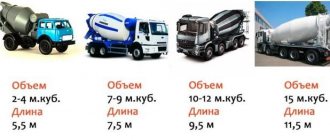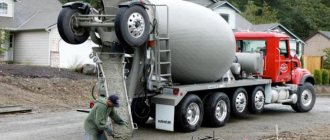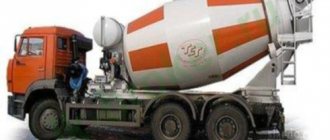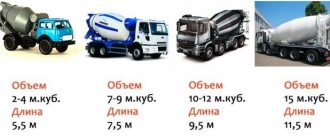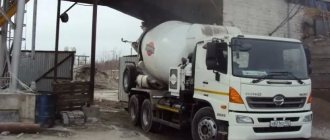Concrete supply using this technology consists of several steps:
- cement pours out of a concrete mixer;
- raw materials are transported to the concreting site;
- the mixture is discharged using a hose and then leveled.
Concrete delivery hoses are a common sight on construction sites. This method is very convenient: the mixture can be delivered horizontally and vertically, delivered to hard-to-reach places, and the process itself is not interrupted. It involves various devices and installations for supplying concrete: a hose, a concrete mixer, a pump, transport, etc. The height of the supply of concrete is controlled by a mixer when the mixture passes through the tray to the concreting site. The tray for supplying concrete can be from 3 to 15 m long. This method is also called supplying concrete with a sleeve.
Questions and answers about concrete delivery by concrete mixer trucks (mixers, ABS)
What volume are mixers (concrete mixers)? In the Moscow region, the most common ones are 7 and 9 cubic meters; machines of 4, 5 and 6 cubic meters are less common; in some places there are even very small mixers with a volume of 2.5 cubic meters.
Outside the city there are often narrow roads with closed turns, and many places cannot be reached by cars with a capacity of more than 5 cubic meters. In Moscow, the volume of cars is from 6 cubic meters (and 6-7 cc cars are not kept everywhere). The main reasons why there are no small mixers:
- due to the large volumes of one-time deliveries, it is unprofitable to keep small concrete mixers,
- small mixers are most often not new, have toxic emissions, and with them there is a greater risk of getting fined,
- In addition, with the tightening of fines for overloading in 2015, many factories switched to delivering incomplete vehicles, and a 5-cubic-meter car can only carry 2-3 cubic meters.
The “Encyclopedia” section provides more detailed information on the products of the leaders of the Russian ABS market, the Tigarbo and TZA companies. Due to lack of demand, companies are reducing the production of small-volume concrete mixers.
What is the length of the hose for concrete mixers (mixers)? Typically the length of the tray (gutter) is from 1.5 to 2 meters. If additional accessories are used, they may be the property of the driver who installed the gutter himself and may require additional payment for its use.
The photo below shows a mixer with a maximum set of trays of 3 sections (1 main and 2 additional). In practice, the gutter most often consists of 1 or 2 sections.
What to do if the standard gutter length is not enough?
- if the distance is up to 5 m: construct an additional gutter (sleeve) yourself (by workers),
- at distances greater than 5 m, the concrete mixture will not flow along the tray on its own due to the low angle. You need to: either use a concrete pump that will deliver concrete over a distance significantly greater than any gutter,
- or hire a large number of workers who will manually (with shovels) drag the mixture along the tray (this option is chosen for pouring into a window or basement, where using a pump is problematic).
Sometimes there are options to use conveyor belts or special wide pipes - but they are quite rare and you should not count on them by default.
What are the sizes of mixers of different sizes? The specific size of a concrete mixer depends not only on the volume of the mixing drum, but also on the brand of chassis on which it is installed. Only the width remains unchanged - 2.55 (large) or 2.50 meters (all other mixers). The average dimensions and number of mixer axes depending on the volume are presented in the table below:
| Volume, m3 | Number of axes | Length, m | Height, m | Width, m | Curb weight, t |
| 4 | 2 | 7,35 | 3,40 | 2,50 | 10 |
| 5 | 3 | 7,40-8,00 | 3,50 | 2,50 | 12 |
| 6 | 3 | 7,80-8,50 | 3,60 | 2,50 | 11,9-13,5 |
| 7 | 3 | 8,20-8,80 | 3,60-3,75 | 2,50 | 12,2-13,9 |
| 8 | 3 | 8,40-9,00 | 3,70-3,85 | 2,50 | 12,8-15 |
| 9 | usually 3 | 8,50-9,20 | 3,70-3,95 | 2,50-2,55 | 13-15 |
| 10 | 4 | 9,30-9,45 | 3,80-4,00 | 2,55 | 15,3-17,2 |
| 11 | 4 | 9,78 | 3,78 | 2,55 | 16,6 |
| 12 | 4 | 9,94-10,36 | 3,82-3,95 | 2,55 | 16,7-19 |
As a rule, the lower value is a mixer based on KAMAZ, the larger value is concrete mixers based on MAZ, Ural or foreign cars (MAN, Mercedes, Iveco, Renault, Ford, Volvo, Scania, Mitsubishi, Hovo, KAMK, Shakman and other brands). Concrete mixers based on all-terrain vehicles (KrAZ, KAMAZ) were not included in the calculation of dimensions.
More detailed information about the dimensions of mixers depending on the manufacturers of the chassis and mixing drum can be found in the “Encyclopedia” section on the pages of the Tigarbo (largest selection) and TZA manufacturers. Other manufacturers do not provide such detailed data.
loaded mixer with concrete weigh Will it be able to travel to my facility? The weight of 1 cubic meter of concrete is 2.4 tons, the weight of a 5 cubic meter mixer is 12 tons, and a 7 cubic meter mixer is a little over 12 tons. Thus, a loaded 5-cubic-meter concrete mixer weighs 24 tons, a 7-cubic-meter concrete mixer weighs 29 tons, and a 9-cubic-meter concrete mixer weighs 35 tons. Due to their heavy weight, concrete trucks require special attention to the road surface. Even if a ZIL arrived at the site with sand (not to mention a passenger car), this does not mean at all that a mixer will be able to drive through it: a ZIL has a total weight of 10-15 tons, while a concrete mixer has 2 times more. You can navigate as follows:
- if there is a hard surface (asphalt, slabs) laid towards the object, the mixer will be able to drive over it. Rolled soil is a hard surface only in dry weather; in rainy weather it can be washed away. If a car cannot enter an object on a paved road, it is the driver’s fault. But there is a note: in some cases, it is not the hardness of the surface that is decisive, but the freedom of space - it is problematic for even a small mixer to drive on narrow roads with closed turns, not to mention large ones,
- grass, soil, snow, sand and crushed stone are not hard surfaces; in some cases driving over them is possible, in others not, you need to navigate according to the specific situation. Since a concrete mixer is expensive and has a high center of gravity with the risk of overturning, the possibility of passage is determined by the driver - the person responsible for the safety of the machine.
Is it possible to deliver concrete using dump trucks - or do you have to use concrete mixer trucks (also called mixers, concrete trucks or concrete mixers)?
According to clause 9.1. GOST 7473-2010 “concrete mixtures are delivered to the consumer by specialized types of transport designed for the transportation of concrete mixtures. By agreement between the manufacturer and the consumer, it is allowed to transport rigid concrete mixtures by dump trucks.” In practice, rigid mixtures are called lean concrete - concrete with a reduced content of cement and a high content of crushed stone. By analogy, there is rich concrete (respectively, with a reduced content of crushed stone and a high content of cement - not used in real practice) and ready-mixed concrete (according to a standard recipe).
Ready-mixed concrete is considered a flexible mixture, for which mobility is standardized (from P1 to P4), lean concrete is considered a rigid and super-rigid mixture (it spreads for a long time or for a very long time under the influence of its own weight, for which rigidity (from Zh1 to Zh4) and super-rigidity (from SZh1) is standardized to SZh3).
Due to its rigidity, when transporting lean concrete in a mixer, there is a very high risk that the concrete will not be able to be dumped out of the barrel, which is why a rule on transportation in dump trucks has been added to GOST. Due to the same risk, road concrete (with mobility P1) is also transported in dump trucks. Therefore, when ordering lean concrete:
- clarify and make sure that there is no misunderstanding in terminology (sometimes lean concrete is called any low-strength concrete, regardless of consistency - and this is incorrect),
- If you figure out that what you need is a hard concrete mixture, don’t be surprised that it is delivered in dump trucks. Moreover, beware of those who offer to deliver it in mixers, because these are usually middlemen (who jeopardize other people's equipment, not their own) or not very experienced employees.
How can I make sure that the mixer contains the exact volume of concrete indicated on the delivery note? A detailed answer to this question is described in a separate article.
How long can it take to unload the mixer? Each manufacturer has its own standard, but for averaging, we can say that 1 cubic meter should be unloaded in no more than 10 minutes; for additional downtime, a fine of 500 to 1000 rubles per hour of downtime is charged.
How is concrete discharged from the mixer? The concrete mixing barrel uses the “Archimedes screw” mechanism. When the barrel rotates clockwise, the concrete moves from one chute to another - but does not spill out of the barrel and still remains in it. But as soon as the barrel begins to rotate counterclockwise, the concrete is unloaded from the barrel, rising from the very bottom to the top.
This video shows a concrete mixer with 1 main and 2 additional chute sections.
Pay attention to the moment of changing the direction of rotation.
I was told that I still need to give the mixer a chance to rinse. What it is? Yes, after pouring, the driver of the concrete mixer washes the gutter so that the remaining concrete does not splash out onto the road or harden on it. A relatively small amount of water is enough for this (
50 l). Carrying out flushing off-site can result in fines, so suppliers often check to see if there is an area where water and concrete residue will remain after flushing.
Conditions and prices for delivery by mixers with 1.5-2m trays.
DELIVERY IN THE CITY
- Minimum delivery volume: 1m3.
- Minimum delivery cost: 2000 rub.
- Delivery cost over 5m3: 400 rub/m3
- additional tray from 4 to 8 m – cost 500 rubles. (delivery of any mixer up to 9 cubes within the city is 4,000 rubles; delivery of up to 10 cubes is 4,500 rubles)
DELIVERY OUTSIDE THE CITY
- Minimum delivery volume: 1m3.
- Orders 5m3 – cost 400 rub./m3 + 100 rub./m3 for every 10 km. outside the ring
- Travel post + 1000 rub./piece.
Free unloading time: 1 hour Quantity in stock: 8 mixers. Volume: 5m3, 7m3, 9m3, 10m3. Mixer tray length: 1.5-2 m. Feed height: 0.5 m.
Features of the technology
Modern concrete mixers are trucks equipped with a rotating concrete mixer. This allows machines to not only deliver material to a site, but also produce it during transportation. Due to the fact that the solution is constantly in motion due to the rotation of the drum, it does not set, which allows the material to be transported over long distances.
It must be said that the history of the emergence of this construction equipment goes back to the beginning of the last century, however, this equipment became widespread in our country in the post-war period. Of course, a lot of time has passed since then, and the design of the machines has been significantly improved.
As a result, modern concrete mixer trucks have a number of additional functions. In addition, they can be equipped with a device for heating the mixture and thermal insulation, which allows the concrete not to freeze at low temperatures.
Thus, we can distinguish three main purposes of this type of equipment:
- Production of concrete mixtures from dry components during transportation from a special installation to a construction site.
- Preparation of mortar at the construction site.
- Transportation of concrete solution with periodic mixing to the construction site.
Note! Modern concrete mixers can be operated at ambient temperatures from -20 to +40 degrees Celsius.
In the photo - pouring concrete
Advantages
The use of this type of equipment in construction has a number of advantages, among which are:
| Versatility | A concrete truck can provide concrete for both small private construction and large multi-storey buildings. |
| Mobility | As mentioned above, the main advantage of these machines is the ability to transport concrete over long distances. A fully loaded vehicle can travel at a speed of about 60 km/h. Moreover, during transportation the material is not exposed to the environment. |
| Concrete preparation speed | The machine allows you to prepare the solution on the construction site in a short time. |
| Ease of unloading | A concrete truck with a hose can not only deliver the solution, but also pour it into the formwork. |
| Economical | Since the solution is prepared during delivery, its price is lower than when produced on stationary equipment in a factory. |
Advice! If it is impossible to ensure access for equipment to the pouring site, use a special pump to deliver concrete with flexible hoses.
Types of concrete mixers
Concrete mixer trucks come in different types, as they are designed for different construction jobs.
Their main differences are in the following points:
- In the location of the mixing container and the direction of discharge of the solution . Unloading can be done backwards or forwards. In the first case, the operating instructions for the concrete mixer require operator participation during unloading.
If concrete is unloaded backwards, the driver can control this operation with his own hands.
- In concrete mixer drive type . It can be mechanical, hydraulic or hydromechanical. The most popular recently are concrete mixers with hydromechanical transmission, which allows you to adjust the drum speed.
Four-axis model with pump and mixer
- Another important difference between concrete mixer trucks is the volume of the concrete truck mixer, which ranges from 1.5 to 12 cubic meters . For small private construction, a small concrete mixer for several cubes is enough.
If the object is large, then use a concrete mixer with a drum volume of 9-12 cubic meters. In some cases, several machines are used simultaneously to deliver and prepare the solution.
- Also the difference lies in the type of chassis . The mixer can be installed on a truck platform or in the form of a semi-trailer. It should be noted that the number of chassis axles depends on the volume of the tank; for large-volume mixers, three-axle or even four-axle chassis are used.
Note! The larger the tank volume, the greater the height of the concrete truck. You should pay attention to this parameter if the access to the object is limited in height by any obstacles.
The volume of the concrete truck is 9 cubic meters
Types of mixers and their parameters
The Kamaz mixer is a truck belonging to the class of special equipment, which is equipped with a rotating pear-shaped container where concrete solution is transported. According to GOST 7473-2010, the mixture does not experience the effects of precipitation, ambient temperatures, or ultraviolet radiation during transportation. The solution remains homogeneous, fresh and of the highest quality, suitable for any task.
When concrete trucks are used for transportation, any risks of cement mortar leakage, drying out, delamination, exceeding the service life, freezing in the cold or early setting are eliminated. If the solution is transported over long distances, various plasticizers are added to the composition to extend the time it retains its properties.
To answer the question of how much concrete is in the mixer, you need to know exactly the model of equipment and brand, and the characteristics of the solution. The most popular on the market today are the models of the Kama Automobile Plant, which produces gravity reversible ABS based on the KamAZ chassis 65115 and 69343, 63963 and 53229-15, etc.
The mixer capacity can vary from 5 to 12 m3. The greatest demand is for equipment with a capacity of 9 cubic meters.
Modern automobile concrete mixers are equipped with a hydraulic drive, which has replaced the mechanical mixing method. After the concrete is immersed in the mixer, the solution is mixed using drums with spiral blades. The mixture is unloaded in the back/forward direction with the reverse rotation of the blades. A modern automixer can deliver concrete at temperatures from -30 to +40 degrees.
- All dry components are loaded into a container, covered with water from the tank, and mixed during transportation.
- Preparation of the mixture at the factory, pouring the finished solution into the mixer, delivery
There are several ways to determine how many cubes of concrete are in the mixer. The volume of the solution in the container is not equal to the geometric volume of the drum itself, but is determined by the capacity/yield of the finished solution. After all, part of the free space is used for effective mixing of concrete. According to GOST, the difference is 4-6 cubic meters.
At the same time, the mixer capacity is a factory technical characteristic by which the maximum load level of the concrete mixer truck is determined. The customer pays for the volume of concrete that is actually delivered, and not for how many cubic meters hypothetically go into the mixer. Thus, the capacity of a Kamaz concrete truck mixer with a geometric volume of 8 m3 delivers a maximum of 5 m3, which is due to the capabilities of the chassis and the carrying capacity of the vehicle.
- Drum volume - affects the speed of the machine, the amount of mixture, and the level of load on the road surface.
- Passability – especially if delivery to remote regions is planned.
- Engine power also affects the speed and ability to transport large volumes of solution.
- The total weight of the equipment - not all loaded mixers can go everywhere, especially if access to the construction site is difficult.
- Drum rotation speed affects the efficiency of concrete mixing.
Construction of concrete mixers
Mixer device
On cars, gravity-driven reversible concrete mixers with a pear-shaped drum are used. The drum must be inclined to the horizontal plane at an angle of 10-15 degrees.
There are helical blades inside the container. When the drum rotates in one direction, they ensure mixing of the solution, and when rotated in the other direction, the solution is completely unloaded.
It should be noted that modern concrete mixer trucks are equipped with a water supply system, which will allow the drum to be flushed of the remaining mixture. They may also have functions such as weighing and dosing. This allows you to prepare high-quality concrete with certain technical characteristics.
Concrete mixer based on a KamAZ vehicle
Platform
Serial trucks are usually used as platforms. Among domestic vehicles, KAMAZ vehicles are the most popular. Moreover, they have become widespread not only in the CIS countries, but also beyond their borders.
Also, KrAZ and MAZ vehicles are often used as platforms for concrete mixers. Among foreign brands, Iveco, MAN, Scania, etc. equipment are very popular.
Types of cars
A concrete mixer with a pump is a special-purpose vehicle whose task is to deliver concrete to a construction site. Thanks to this, the pouring process is accelerated several times, and the concrete does not have time to lose its properties.
Such machines are quite expensive and it is not practical to buy them for the construction of a small facility. Therefore, today you can find specialized companies engaged in renting out such equipment.
Automixers with a pump are divided into several groups, depending on:
- concrete supply method;
- feed boom length;
- unit power;
- type of autonomy.
In turn, the delivery method can be:
- Porshnev. In this case, a piston mechanism is used to supply concrete. Such units come with a slide valve and dividing curtain valves.
- Vacuum. The concrete solution is fed into the container using an airless environment that is created here.
According to the method of autonomy, cars are divided into:
- Stationary. The unit is characterized by high power, reliability and the ability to use it even in difficult conditions. But this technique has disadvantages. For example, to deliver it to a construction site you will need a special platform. To supply concrete, a hose wire is provided here, instead of a mounting boom.
- Mobile. The demand for such equipment is maximum. A concrete mixer with a concrete pump is a compact, mobile equipment whose task is to deliver and pump the mixture. They are compact and easy to use, which is why they are in high demand.
Conclusion
A concrete truck, in fact, is an alternative to bulky stationary installations for preparing concrete, but unlike them, it is mobile. In addition, a wide variety of types of concrete mixer trucks allows them to provide concrete to almost any type of construction site. As a result, these machines are one of the most common types of construction equipment (learn how to pour a concrete floor yourself here).
You can get more information on this topic from the video in this article.
Pouring concrete from a mixer
Not a single building is complete without the construction of a foundation. Compliance with the technological process of laying the concrete mixture affects the durability and strength of the structure. They lay the foundation with special responsibility, adhering to the order of work. The construction of the foundation begins with marking, digging a hole, reinforcement and installation of formwork. After the preparatory work is completed, the concrete begins to be poured.
The process of laying the solution is carried out manually or using specially designed equipment and mechanisms. What type of fill should I choose for the construction of the structure? This is a decision for the builder to make: either it will be an economical option to prepare it yourself, or a more expensive, but also high-quality option of using an automated concrete mixer.
Conditions and prices for delivery by mixers with a 10m long feed belt.
DELIVERY IN THE CITY
- Minimum delivery volume: 1m3.
- Minimum delivery cost: 6000 rub.
- Delivery cost over 6 m3: 1000 rub./m3
DELIVERY OUTSIDE THE CITY
- Minimum delivery volume: 1m3.
- Orders 6m3 – cost 1000 rub./m3 + 500 rub./m3 for every 10 km. outside the ring
- Travel post + 1000 rub./piece.
Free unloading time: 1 hour Quantity in stock: 2 mixers. Volume: 6m3, 8m3. Tape length: 10m. Feeding height: up to 3m.
We work in Stavropol: in the region, in the districts and in the region
Ours accepts orders for the purchase of concrete with delivery in Stavropol, the region and the region. We work in city districts, microdistricts: Aleksandrovskoye, Divnoye, Arzgir, Blagodarny, Budennovsk, Georgievsk, Grachevka, Izobilny, Ipatovo, Novopavlovsk, Kochubeevskoye, Krasnogvardeyskoye, Kursavka, Kurskaya, Levokumskoye, Mineralnye Vody, Neftekumsk. See also, Novoaleksandrovsk, Novoselitskoye, Svetlograd, Essentukskaya, Zelenokumsk, Stepnoe, Donskoye, Summer Headquarters, Mikhailovsk. Александровское, Дивное, Арзгир, Благодарный, Буденновск, Георгиевск, Грачевка, Изобильный, Ипатово, Новопавловск, Кочубеевское, Красногвардейское, Курсавка, Курская, Левокумское, Минеральные Воды, Нефтекумск, Новоалександровск, Новоселицкое, Светлоград, Ессентукская, Зеленокумск, Степное, Донское, Летняя Headquarters, Mikhailovsk, Kiselevka, 26th microdistrict, 12th microdistrict, 31st microdistrict, 2nd microdistrict, 28th microdistrict, 16th microdistrict, 10th microdistrict, 9th microdistrict, 11th microdistrict , 18th microdistrict, 3rd microdistrict, 13th microdistrict, 14th microdistrict, 4th microdistrict, 17th microdistrict, 8th microdistrict, 15th microdistrict, 6th microdistrict, 20th microdistrict , 24th microdistrict Hide
EUROEXPRESS
Concrete at manufacturer prices with delivery throughout the city and region
The site uses cookies. When using the site, we process your data so that interaction with our site is as informative as possible and meets your interests.
We accept payment
Contact us
Our address: Stavropol, Selektsionnaya str., 5v
Telephone:
Our partners
Benefits of using a mixer
The mixer is an automated concrete mixer that delivers a specified volume of concrete to the workplace. The advantages of mixers are as follows:
- laying with a mixer is carried out over several hours, which reduces the time for construction work;
- the quality of the finished solution from the mixer is higher than that prepared by hand;
- the mixture from the concrete mixer comes out to the required consistency, which simplifies the work of leveling the surface;
- pouring concrete from a mixer is carried out throughout the day, and when making the mixture manually, it may take a week to pour the solution;
- has no difficulties in calculating the amount of the required solution;
- the mixture prepared at the factory contains additives, plasticizers, and modifiers that improve the waterproofing of the building mass;
- obtaining a homogeneous structure by mixing the mixture in a concrete mixer during transportation.
Return to contents
How to calculate the volume in a concrete mixer?
To calculate the actual volume of concrete mixture brought in the mixer, it is necessary to determine its net weight. For example, control weighing showed a result of 19.2 tons (19,200 kg), and the documentation indicated the delivery of 8 cubic meters. m. By dividing the coefficient 19,200 by 8, the result is 2400 kg/cubic meter. m, and in accordance with the invoice, the density of the solution must be at least 2500 kg/cubic meter. m. When dividing the real net indicator again by the estimated density index, the cubic capacity does not correspond to reality (instead of the required 8 cubic meters, the supplier delivered 7.68 cubic meters).
To ensure that the actual volume of concrete solution corresponds to the cubic capacity indicated in the invoice, you should contact trusted suppliers who care about their own reputation. Our company offers to purchase exclusively high-quality concrete wholesale and retail, guaranteeing maximum quality of services.
Disadvantages of solution preparation
Builders who want to save money make the mortar themselves, but completely forget that when laying the mixture in parts, the foundation ends up with worse technical characteristics. The concrete base turns out to be of poor quality due to the fact that stale cement, prepared many hours before its production, is used to lay it.
Construction companies provide concrete mortar, which is made using mixers with a volume of two to ten cubic meters. Manufacturing companies with a large turnover of products use specially designed vehicles to transport concrete mortar. The use of special equipment for transporting the mash increases the cost of the finished mixture.
Types of submission
When transporting concrete mortar over a distance or height, it is necessary to maintain the technical characteristics of the material. In practice, 2 methods of movement are used to supply the mixture:
- Continuous technology. You can lift concrete to the immediate location using a hose, pipeline or conveyor-type machine. The method is used when the material is prepared at the installation site or when large-scale objects are being constructed.
- Cyclic transportation. The complex method consists of 2 stages. Initially, the cargo is delivered by a special vehicle - a mixer, a dump truck, a concrete truck, containers on watercraft or railway tanks. Further transfer is carried out through hoses and a pump directly for pouring into the formwork.
When constructing structures, a combined method of delivering concrete from the manufacturer to the installation site is used.
Preparatory work
Pouring the foundation with an automated concrete mixer begins with preparing the work site where the construction of the facility is planned. Preparatory work consists of marking and digging a trench, gravel is laid at the bottom and formwork is installed. When laying the mixture along the entire perimeter of the object, it is important to control the evenness of the top layer of coating; for this, use a stretched fishing line.
Next, prepare the construction site on which it is planned to lay the working mixture. Before pouring concrete, check its hardness after transportation. If the mixture has hardened, pre-prepared water is poured into it. The surface on which it is planned to lay the concrete solution is cleared of construction debris and dust.
Purpose of concrete trays
Such a structure is intended for pouring mortar into the formwork of the future foundation of the building. From the concrete mixer, the mixture is supplied through a chute to its destination. However, if concrete is poured at the same point, then due to the uneven placement of the mixture, a flat surface of the designed foundation will not be obtained.
In this case, beware of delamination in concrete, when the watery part of the solution flows into the far corners of the formwork, and the denser part remains at the pouring point. By making mistakes when supplying the concrete mixture using a special tray, you can create a low-quality foundation that will soon begin to deform.
Therefore, be sure to create conditions for the smooth movement of the concrete mixer around the construction site so that there is access to any corner of the future structure. If in some places this is not possible, the length of the gutter should be increased in order to reach hard-to-reach corners.
Return to contents
How to properly lay concrete?
During the process of laying the concrete mixture for the construction of the foundation, it is carefully compacted using deep vibrators. Tamping can also be done using ordinary steel reinforcement. The concrete composition is compacted until air bubbles disappear, which negatively affect the cast structure of the concrete base for buildings and structures. After removing air bubbles, begin leveling the top layer of the base using a trowel.
In some cases, to achieve a good result, you should not save on building materials and equipment, but use automated mechanisms that allow you to lay high-quality concrete mortar.
Concrete mixer trucks (mixers)
What is the volume of mixers (concrete mixer trucks)?
In practice, most often - 5 and 7 cubes, machines with 4 and 6 cubes are less common, somewhere there are even very small mixers with a volume of 2 cubes. Outside the city there are often narrow roads with closed turns, and many places cannot be reached by cars with a capacity of more than 5 cubic meters.
In the city - from 7 cubic meters and above. The main reasons why there are no small mixers:
- due to large volumes of one-time deliveries, it is unprofitable to keep small mixers,
- Small mixers are most often not new, have toxic emissions, and with them there is a greater risk of getting fined.
How much does a mixer with concrete weigh (loaded)?
The weight of 1 cubic meter of concrete is 2.4 tons, the weight of a 5 cubic meter mixer is 11 tons, and a 7 cubic meter is a little over 12 tons. That is, a loaded 5-cubic mixer weighs 23 tons, a 7-cubic mixer weighs 29 tons.
What length are the sleeves of mixers?
Usually - from 1.5 to 2 meters.
If additional accessories are used, they may be the property of the driver who installed the gutter himself and may require additional payment for its use. The website of the mixer manufacturer Tigarbo shows the following photo:
This is the maximum configuration of the gutter with 3 sections (1 main and 2 additional). In practice, they most often consist of 1 or 2 sections.
What size is the mixer that will come to me?
The specific size of the machine depends not only on the volume of the mixing drum, but also on the brand of chassis on which it is installed.
Only the width remains unchanged - 2.55 (large) or 2.50 meters (all other mixers).
The average dimensions and number of mixer axes depending on the volume are presented in the table below:
| Volume, m3 | Number of axes | Length, m | Height, m | Width, m |
| 4 | 2 | 7,35 | 3,40 | 2,50 |
| 5 | 3 | 7,40-8,00 | 3,50 | 2,50 |
| 6 | 3 | 7,80-8,50 | 3,60 | 2,50 |
| 7 | 3 | 8,20-8,80 | 3,60-3,75 | 2,50 |
| 8 | 3 | 8,40-9,00 | 3,70-3,85 | 2,50 |
| 9 | 3 | 8,50-9,20 | 3,70-3,95 | 2,50-2,55 |
| 10 | 4 | 9,30-9,45 | 3,80-4,00 | 2,55 |
As a rule, a lower value is a mixer based on KAMAZ, a larger value is based on a MAZ, Ural or foreign cars. Mixers based on all-terrain vehicles were not included in the calculation of dimensions.
More detailed information about the dimensions of mixers depending on the manufacturers of the chassis and mixing drum can be found in the “Encyclopedia” section on the pages of the manufacturers Tigarbo (the largest selection), TZA, Becema. Other manufacturers do not provide such detailed data.
What to do if the standard gutter length is not enough?
The most commonly used options are to construct the gutter yourself (with workers) or use a concrete pump, which will deliver concrete over a distance much greater than any gutter.
How long can it take to unload the mixer?
Each manufacturer has its own standard, but for averaging, we can say that 1 cubic meter should be unloaded in no more than 10 minutes; for additional downtime, an additional fee of 1,200 rubles per hour of downtime is charged.
How is concrete discharged from the mixer?
The concrete mixing barrel uses the “Archimedes screw” mechanism.
When the barrel rotates clockwise, the concrete moves from one chute to another - but does not spill out of the barrel and still remains in it. But as soon as the barrel begins to rotate counterclockwise, the concrete is unloaded from the barrel, rising from the very bottom to the top.
I was told that I still need to give the mixer a chance to rinse. What it is?
Yes, after pouring, the mixer driver flushes the chute to prevent any remaining concrete from hardening on it.
A relatively small amount of water is enough for this (
Carrying out flushing off-site is fraught with fines, so concrete suppliers check to see if there is a site where water and concrete residues will remain after flushing.
The Buyer is obliged to provide access roads to the facility to which the goods are delivered, allowing for the unhindered unloading (delivery) of goods using the Supplier’s vehicles and special equipment. If access roads to the facility are not provided, the Buyer is obliged to ensure the evacuation of vehicles and special equipment at its own expense and on its own.
The buyer is obliged to provide a place for washing vehicles and special equipment at the construction site.
ABS technical specifications
The safety of the concrete mixture during transportation is ensured by the constant rotation of the drum, inside of which there is a mechanism with mixing blades. The mixer is unloaded by the reverse movement of the blades. When ordering a concrete mixer truck, you must consider the following characteristics:
- Drum volume. Manufacturers of construction equipment produce drums of various sizes: from mini-mixers of 2 m 3 to large ones of 15 m 3. Mixers of impressive volume are used in the construction of large-scale projects, for example, when pouring a foundation;
- Mixer filling capacity. Given the stated technical characteristics, it is worth considering that ABS is almost never filled to capacity. This is due to the tightening of fines for overloading since 2015. As a rule, the actual filling of the drum is 1-3% lower than the maximum;
- Sleeve or gutter length. The device through which concrete is unloaded from the mixer has a length of 1.5-2 m. Suppliers often offer elongated hoses, and the unloading time increases accordingly;
- Weight of loaded concrete mixer truck. This parameter is important when delivering within the city, where there are weight restrictions for special vehicles, as well as when driving the vehicle on viscous soil. In many cases, it is more economical to order two or three 6-cc mixers instead of one per 12-15 m 3.
What do you need to know about transporting ready-mixed concrete?
Question: How to properly transport concrete mix to the construction site? What nuances do you need to know in order to get a high-quality mixture for the object?
Proper transportation and unloading of ready-mixed concrete
During the construction of civil and industrial buildings (structures) located within large cities or in their suburbs, it is carried out using ready-mixed concrete, which is ordered from concrete manufacturing plants.
It is not effective to deliver concrete over long distances (more than 70 km), since its cost is very high due to long-distance delivery. Ready-mix concrete can be delivered to a construction site using dump trucks or concrete mixer trucks (popularly called “mixers”).
The main requirements for concrete during its transportation are to preserve its basic properties (design grade strength, mobility and homogeneity) and to prevent the mixture from separating.
Transporting a concrete mixture using a dump truck can be justified over short distances (maximum 15 km, taking into account the good quality of the road surface), since in this case, the concrete mixture often delaminates and requires additional mixing immediately before laying.
Delivery of concrete mix by concrete mixer trucks
Let's briefly look at what concrete mixer trucks are, photo 1.
As noted above, ready-mixed concrete is transported by concrete mixer trucks, which allow the basic properties of concrete to be preserved during its transportation. All concrete mixer trucks are made on the basis of KAMAZ, KRAZ, MERSEDEC, etc. trucks. The machines are equipped with a barrel-shaped container of various volumes, equipped inside with blades for mixing the concrete mixture using an engine.
All concrete mixer trucks have their own classification based on the following criteria:
- drum drive type: mechanical or hydraulic;
- unloading directions: unloading “forward” or “backward”;
- mixer motor type: stand-alone and “engine on chassis”.
Advantages of delivering concrete by concrete mixer trucks
Using concrete mixer trucks to deliver concrete mixture has a number of advantages:
- the concrete mixture can be directly prepared in concrete mixer trucks while on the way to the construction site (a dry mixture of all concrete components is loaded into the drum, and then, when approaching the construction site, the required amount of water is added and a “fresh” concrete mixture is prepared by mixing). This method increases the time to ensure the mobility of the concrete mixture and the permissible transportation distance (100...200 km);
- ensures the homogeneity of the concrete mixture and prevents it from separating;
- protects the concrete mixture from atmospheric influences: sunlight, wind, precipitation, etc.;
- the volume of concrete mixture that can be transported using one concrete mixer truck is 3...12 m 3 ;
- Some concrete mixer trucks are equipped with an additional unloading pipe up to 8 meters long, which allows you to unload concrete mixture in hard-to-reach places.
Depending on the type of concrete mixture and ambient air temperature, the duration of transportation should not exceed 45 minutes, and for some concretes up to 1.5 hours. After this time, the concrete begins to set, which leads to the impossibility of normal laying and a significant decrease in the strength of the concrete. Concrete mixer trucks are capable of operating at temperatures from 0 ○ C to +40 ○ C, and some types even at temperatures from –17 ○ C.
Unloading concrete mixture
The concrete mixture can be supplied to the concreting site in different ways, and this depends on the type of structure, its height relative to ground level, the properties of the concrete mixture and the volume of work performed. Unloading concrete at a construction site can be done in several ways:
- If a specific object or concreting element is located in such a place that a concrete mixer truck can easily drive up, then unloading can occur directly from the mixer into trays, photo 2.
- If a construction site or concreting element is located in a place that is difficult to reach for a mixer, then the concrete mixture is reloaded from a concrete mixer truck into a bucket or concrete pump, and then supplied to the specified location, photos 3 and 4.
Also, when the concreting object is below ground level (pit), then first there is a reloading into a bucket, and then through a vibrating chute directly into the concreting block. If the concreting unit is at a height, the concrete is unloaded into a bucket and then transported to the desired location using cranes. The tub is filled to 0.9…0.95% of the total volume. The capacity of the tub can usually be as follows: 0.3; 0.6; 0.8; 1.0 m3.
- Supplying concrete mixture using concrete spreaders is effectively used for monolithic construction of small-sized foundations. Concrete pavers are self-propelled machines that take on concrete mixture and deliver it to the right place in the right quantity, photo 5.
Layout diagrams
Hanging system
It is used if the supply of concrete for pouring the structure (the foundation itself acts as it) is carried out over a short distance with an offset. To create such a structure, you will need a rope, from which the gutter is suspended using cables passing through two blocks.
One end of the rope is attached to a pole or column, and a load is hung on the opposite end and lowered to the ground. The load is also hung on the ends of the cables in such a way that they can be used to adjust the angle of inclination of the system.
If a system such as a foundation is to be erected for a large structure, then to maintain a constant angle of inclination it is necessary to install a taller rope tower or install additional pillars. It is the auxiliary pillars that will receive concrete from the main tower.
Gutters with jibs
This arrangement is appropriate if concrete for the foundation is supplied at a distance of no more than 60 meters.
The lower end of the gutter is suspended and attached to the jib.
The jib is a metal lattice truss, one side of which rests on the lower skid, and its upper edge is connected to the upper skid using a lifting cable.
In order for the slope of the gutter to remain unchanged while the concrete solution passes through it, its lower end is attached to the ground using cables.
Sprengel groove
The simplest design, which involves hanging the lower end of the gutter from a support.



